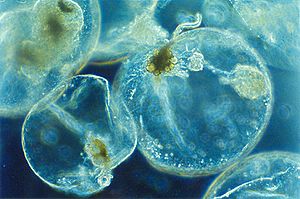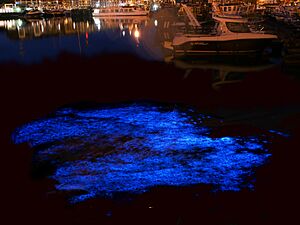Noctiluca facts for kids
Quick facts for kids Noctiluca scintillans |
|
|---|---|
 |
|
| Scientific classification | |
| Domain: | |
| (unranked): |
Sar
|
| (unranked): | |
| Phylum: | |
| Class: |
Dinophyceae
|
| Order: |
Noctilucales
|
| Family: |
Noctilucaceae
|
| Genus: |
Noctiluca
|
| Species: |
N. scintillans
|
| Binomial name | |
| Noctiluca scintillans (Macartney) Kofoid & Swezy, 1921 |
|
| Synonyms | |
|
Noctiluca miliaris |
|

Noctiluca scintillans, often called the sea sparkle, is a tiny living thing found in the ocean. It's a type of dinoflagellate, which is a group of single-celled organisms. These amazing creatures float freely in the sea.
Contents
What is Bioluminescence?
Noctiluca scintillans is famous for its special ability to glow. This glow is called bioluminescence. When the water around them is disturbed, like by a boat or a wave, they light up! This can create a beautiful "milky seas effect" where large areas of the ocean seem to sparkle.
How does the sea sparkle glow?
The glow comes from inside the Noctiluca cell, specifically from its cytoplasm. It happens because of a chemical reaction involving two special substances: luciferin and luciferase. This reaction takes place in thousands of tiny, round parts inside the cell called scintillons. Not all types of Noctiluca can glow; only the ones with these scintillons produce light.
What does Noctiluca eat?
Noctiluca is a heterotroph. This means it cannot make its own food, unlike plants that use sunlight. Instead, it gets its energy by eating other small organisms. It uses a process called phagocytosis, where it basically "swallows" its food.
Favorite foods of the sea sparkle
Noctiluca eats a variety of tiny sea creatures. Its diet includes plankton, diatoms, other dinoflagellates, fish eggs, and even bacteria. One of its favorite foods is a type of diatom called Thalassiosira.
Living with tiny helpers
Sometimes, Noctiluca scintillans takes in very small phytoplankton. These phytoplankton are like tiny plants that live inside the Noctiluca cell. This relationship is called endosymbiosis.
Photosynthesis inside Noctiluca
The phytoplankton inside Noctiluca are special because they can do photosynthesis. This means they use sunlight to make food, just like plants do. Even though Noctiluca itself doesn't do photosynthesis, it benefits from the food made by its tiny phytoplankton helpers. You can often find these diatoms stored in special compartments inside Noctiluca called vacuoles. These green helpers can continue to grow and make food for many generations while living inside Noctiluca.
See also
 In Spanish: Chispa de mar para niños
In Spanish: Chispa de mar para niños

